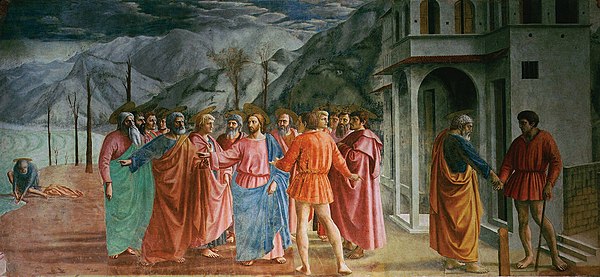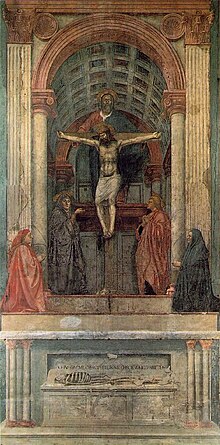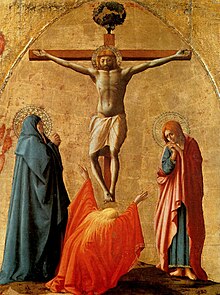Masaccio
Tommaso di ser Giovanni di Mone Cassai (San Giovanni in Altura, today San Giovanni Valdarno, Arezzo, December 21, 1401 – Rome, autumn 1428), better known as Masaccio , was an Italian 14th century painter. Despite the shortness of his life, his work had a decisive importance in the history of painting. It is generally considered that he was the first to apply to painting the laws of scientific perspective, developed by Brunelleschi.
Biography
He was born in Castel San Giovanni, today San Giovanni Valdarno, on December 21, 1401, the son of the notary Giovanni di Mone Cassai and his wife Jacopa di Martinozzo. The surname Cassai comes from the name of the activity to which Masaccio's paternal family was dedicated: they were cabinetmakers (in Italian, cassai). In 1406, coinciding with the birth of the couple's second son, Giovanni —who would later receive the nickname "el Scheggia"—, his father died. His mother remarried the spice merchant Tedesco di Mastro Feo, also a widower, and with two daughters, who died on August 7, 1417.
Masaccio moved to Florence between 1417 and 1421, perhaps because of the death of his stepfather. There are documents that show that Masaccio's mother rented a house in this city, in the San Niccolò Oltrarno neighborhood, probably as a home for her son, since she continued to live in the house of her late husband. It is possible that the young artist began his career in Florence in the workshop of Bicci di Lorenzo or in that of someone else. On January 7, 1422, he enrolled in the Art (guild) of doctors and grocers, which indicates that he was already practicing as a freelance painter in the city of the Arno.
His first secure work is the triptych for Saint Juvenal of Casia, which bears the date, on the central panel, of April 23, 1422: ANNO DOMINI MCCCCXXII A DI VENTITRE D'AP[RILE]. It is possible, as Vasari implies, that in 1423 Masaccio made a trip to Rome, on the occasion of the jubilee. In 1424 he enrolled in the Company of Saint Luke in Florence. Possibly this year or in 1425 he began to collaborate with Masolino on the frescoes in the Brancacci chapel of the church of Santa Maria del Carmine in that city. In February 1426 he began the Pisa Polyptych, a work that would occupy him for most of the year.
In 1428 he moved to Rome, invited by Cardinal Brando da Castiglione to decorate the chapel of San Clemente in the church of the same name. In Rome he worked on the Polyptych of Saint Mary Major, of which "Saints Jerome and John the Baptist" are preserved (now in the National Gallery, London). He died in Rome in the autumn of 1428, when he was only twenty-seven years of age. Some ancient sources mention the rumor that he was poisoned.
Pinsi, and my pitture when I see fu pari;
l'atteggiai, l'avvivai, le diedi il moto,
le diedi affetto; insegni il Buonarroto
a tutti gli altri, e da me solo impari.Annibal Caro Epigram
Work
Triptych of Saint Juvenal
The Triptych of Saint Juvenal was an unknown work by Masaccio, not mentioned by his biographer Giorgio Vasari, which was rediscovered in 1961. The painting consists of three panels: the central one represents the Virgin with the Child, flanked by two angels; on the side panels there are pairs of saints: San Bartolomé and San Blas in the one on the left, and San Juvenal and San Antonio Abad in the one on the right. The central panel contains the inscription that has allowed the work to be dated: ANNO DOMINI MCCCCXXII A DI VENTITRE D’AP[RILE]. The composition is built according to the laws of perspective: the vanishing lines of the pavement of the three panels converge in a central vanishing point, represented by the right hand of the Virgin, which supports the feet of the Child.
Brancacci Chapel
In 1424, Masaccio and Masolino began the decoration of the Brancacci Chapel, in the transept of the church of Santa Maria del Carmine. The chapel had been built in accordance with the will of Pietro Brancacci, but it was Felice Brancacci, a prosperous silk merchant who had held several important political offices in Florence, who entrusted the decoration of the chapel to Masaccio and Masolino. The two painters worked in a perfectly coordinated way: both worked on the two walls of the chapel, and gave great unity to the composition, thanks to the use of the same color range, and a single point of view (that of a spectator located in the center of the chapel). When Masolino left for Hungary in September 1425, Masaccio continued to work alone. Later, after the departure to Rome and subsequent death of Masaccio, the work was interrupted. In 1436 Felice Brancacci was banished from Florence as the Medici family rose to power. The decoration of the chapel was only finished in 1481 by Filippino Lippi. Between 1746 and 1748 important transformations were carried out in the chapel, and in 1781 it suffered significant damage due to a fire that blackened the frescoes. They were restored in 1988, returning to the original color.
The frescoes are distributed on two horizontal levels along the two walls of the chapel (originally there were also paintings in the lunettes and on the vault, all of them by Masolino). The characteristic scheme of Florentine fresco painting is followed, consisting of arranging the compositions as if they were paintings placed on the wall, and, to highlight this idea, each scene is framed by classical pillars and painted Corinthian capitals.
The main theme of the frescoes is the story of the life of Saint Peter, patron saint of sailors and sea traders, and there are also some references to Genesis, specifically the story of Adam and Eve. The iconographic program has been interpreted in relation to the personality of the principal: Felice Brancacci had been one of the first consuls of the sea in Florence in 1421, and between 1422 and 1423 he was ambassador in Cairo.
Iconographic program
1. Upper body:
- The expulsion of Adam and Eve from earthly paradise (Masaccio)
- The tribute (Masaccio)
- Prediction of Saint Peter (Masoline)
- Baptism of the neophytes (Masaccio)
- Resurrection of Tabita (Masolino, with interventions by Masaccio)
- Adam and Eve in earthly paradise (Masoline)
2. Lower body:
- St. Peter in prison visited by St. Paul (Philippine Lippi)
- The Resurrection of the Son of Theophilus and Saint Peter in the Chair (Masaccio)
- Saint Peter heals the sick with his shadow (Masaccio)
- The distribution of goods and the death of Ananias (Masaccio)
- Dispute of Saint Peter with Simon Mago and death of Saint Peter (Philippine Lippi)
- San Pedro released from prison (Philippine Lippi)
The sources are the Acts of the Apostles, for the paintings related to Saint Peter, the Gospels, for the fresco of The Tribute, and Genesis, for the two scenes of Adam and Eve.
On the left side wall there are four scenes composed by Masaccio: two at the top, The expulsion of Adam and Eve from the earthly paradise, The tribute; and two at the bottom The resurrection of the son of Theophilus and Saint Peter in the chair , and Saint Peter heals the sick with his shadow . Alongside these works by Masaccio are others by Masolino, and some later by Filippino Lippi.
On the right side wall are, in the upper part, The baptism of the neophytes; and in the lower The distribution of goods and the death of Ananias. In addition, it is believed that the buildings that appear in the background of Masolino's fresco on the Resurrection of Tabitha are also the work of Masaccio.
Stylistic analysis
- The expulsion of Adam and Eve from earthly paradise: this painting is frequently compared to that of Adam and Eve in earthly paradiseMade by Masolino on the wall opposite. While Masolino's work still belongs to the Gothic, Masaccio's work is already present the Renaissance. The treatment of the nude refers to models of Antiquity (for Adam, it has been thought that Masaccio may have been inspired by statues of Mars or Laoconte; for Eve, one of the Roman pubic venus). The scene's pateticism is accentuated by the painful cry of Eve and the contracted belly of Adam, who takes air.
- The tribute: the scene narrated in a passage from the Gospel of Matthew is described (Matthew 17:24-27: When Jesus and his disciples were asked in Capernaum to pay the tribute for the temple, this commands Peter to fish, in which he will find the coin of the tribute.
Masaccio represents three successive events in a single space. The scene is divided into three parts: in the center of the fresco the collector, with his back turned, in a red tunic, requests payment of the tax, and Jesus orders Peter, with a gesture that the apostle repeats, what he has to do; to the left of this scene (he does not appear in the image) appears Pedro, making an effort to remove the coin from the fish he has just caught; Finally, on the right, Pedro pays the tribute to the collector before a building in perspective. This scene has been related to the new maritime interests of Florence (we must not forget that the commissioner of the work, Felice Brancacci, had been consul of the sea): the idea that is suggested, then, is that of the sea as a source of income for the Republic. Some authors have pointed out Masolino's interventions in this painting. Argan suggests another interpretation of the theme: «Masaccio is too educated and too humanist not to understand the deep meaning of the theme: only Peter, as head of the Church, will have to deal with the world, with earthly powers».
- The baptism of the neophytes: the subject here comes from the Acts of the Apostles, and specifically from Acts 2:41.
- The Resurrection of the Son of Theophilus and Saint Peter in the Chair: the source of this scene is not found in the New Testament, but in the Golden Legend of James of the Voragine: Toofilo, prefect of Antioch, accepted to release Saint Peter on condition that he would raise his son from fourteen years. After the success of the Apostle, Theophilus and many inhabitants of the city became Christianity. Masaccio unfinished this fresco, which was completed by Filippino Lippi. It is believed that in him portraits of characters of the time can be found: in the group of the left, the character dressed in Carmelite habit is probably Cardinal Brenda Castiglione; Theophilus, sitting on the throne in the form of niche, is a portrait of Gian Galeazzo Visconti, great enemy of Florence; and Coluccio Salutati is the figure sitting at the feet of Theophilus, on the right.
- Saint Peter heals the sick with his shadow: it is believed that in this scene there are also portraits of characters of the time. The character on the right of St.Peter, with a red hood, is surely Masolino, while the figure of St.John, on the left of St.Peter, is considered a self-portrait of Masaccio himself (according to others would be his brother Giovanni, called the Scheggia). The man miraculously healed (on foot and with hands together) is perhaps a portrait of Donatello.
- The distribution of goods and the death of Ananias illustrates an episode of the Acts (Acts 5:1-11) about the punishment of Ananias, who tried to deceive the community of the early Christians, and fell fulminated by God. This scene is closely related to the previous one.
The Trinity
Between 1426 and 1428 Masaccio painted the fresco of the Trinity on one of the side walls of the Florentine church of Santa Maria Novella. In this mural, use is made for the first time of the theory of perspective. The painting represents the dogma of the Trinity, within the framework of a chapel inspired by Roman triumphal arches, with a half-barrel vault divided into coffers and supported by Ionic columns, flanked in turn by pilasters that support an entablature. In the center is the crucified Christ, sustained by God the Father —the only figure that escapes the laws of perspective, as an incommensurable being—; under the cross are the Virgin Mary and Saint John the Evangelist. Below are the two patrons, recently identified as Berto di Bartolomeo del Banderaio and his wife Sandra, who attend the sacred scene on their knees. Below them, and functioning as the base of the composition, there is a marble altar under which a recumbent skeleton can be seen, accompanied by the inscription: «I was before what you are; and what I am now you will be tomorrow" ("Io fu già quel che voi sete: e quel chi son voi ancor sarete").
The painting can be read vertically upward, as the ascent towards eternal salvation, from the skeleton (symbol of death) to eternal life (God the Father), passing through prayer (donors), the intercession of the saints (Saint John and the Virgin), and redemption (Christ crucified). Masaccio's use of perspective makes the composition a true trompe l'oeil or trompe l'oeil that makes it appear that the wall is actually perforated.
Polyptych of Pisa
On February 19, 1426, Masaccio began the polyptych for the chapel of the notary Ser Giuliano di Colino degli Scarsi da San Giusto in the church of Santa Maria del Carmine, in Pisa. The polyptych consisted of 19 tables. Along with archaic features, such as the use of a gold background, the main novelty was that all the panels had a single vanishing point, so that the composition was unitary. In the 18th century, the polyptych was dismembered: the 11 pieces that have been recovered are currently kept in 5 different museums. The most important are the following:
- Virgin on the throne with the Child and four angels(London, National Gallery).
- Crucifixion (Capodimonte Museum of Naples): this table occupied the central top of the polyptic, above the Virgin on the throne. It represents the scene of the crucifixion of Jesus, as it is referred to in the Gospel of John (John 19:26-27with the Virgin on the right of Christ and Saint John on his left. The supplicating figure at the foot of the Cross represents Mary Magdalene, and several authors believe it was added later. It still has archaic features, related to the international Gothic, such as the gold background. As the table was meant to occupy a very high place as a central auction of the altarpiece, the figure of Christ was painted in a way that would correct the optical alterations that would occur when the work so high in relation to the viewer remained.
- Saint Paul (National Museum of Pisa)
- The Adoration of the Magi (Berlin, Staalitche Museen): it is the central table of the Predela of the Polyptic, and the only one in which the gold background is not used. Vasari commented on this work: "In this part there are some horses, taken from the natural, so beautiful that can no longer be asked, and the men of the court of the three Kings are dressed with various outfits that were used in those times». The current criticism has emphasized that the center of attention of the painting moves from the sacred scene to the profane courtship. According to some authors, the palafrenero that stands between the two-horse snouts can be an author-portrait of the painter.
Other works
One of the earliest known works is Madonna and Child and Saint Anne, in the Uffizi Gallery in Florence, which he painted with Masolino around 1423–1424. Rome most likely corresponds to a panel that is part of a triptych painted for the Basilica of Santa Maria Maggiore (the other two panels, according to the opinion of current critics, would be the work of Masolino). The panel represents Saint Jerome and Saint John the Baptist and is now kept in the National Gallery.
There is also a Crucifixion, generally attributed to Masolino, painted in fresco on the back wall of the chapel of Santa Catalina in the basilica of San Clemente: some authors have believed they saw in this works the hand of Masaccio, although there is no agreement on this matter.
Contenido relacionado
Miyamoto Musashi
Chilean coat of arms
Overture 1812
Lyre (musical instrument)
Astor Piazzolla







